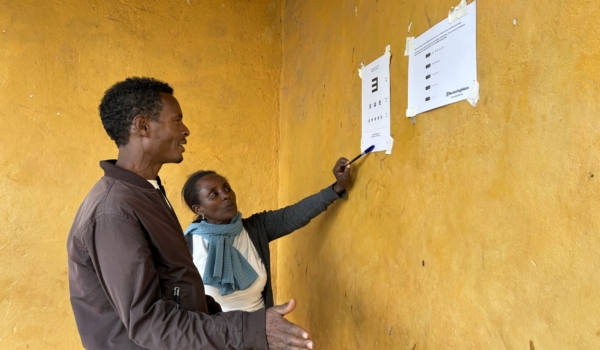When a woman in your neighborhood needs care during pregnancy, how long does she have to travel to be seen by a nurse or a doctor?
When we started our work in Gboe District, Liberia it was common for pregnant women to deliver at home because there was no clinic or hospital anywhere in the district. Agnes Panman, a young woman from one of the district’s remote communities, was born in her family’s home in the same small community where she still lives today. There was no clinic anywhere in Gboe District when Agnes was born or when she delivered her first child a year ago, but she was fortunate to have delivered safely. If a woman in Gboe developed complications during pregnancy or delivery, her family and neighbors would have to fashion a cloth hammock between bamboo poles and carry her for two days – taking shifts as their arms grew tired – to bring her to the nearest clinic dozens of miles away.
Unfortunately, Gboe is not unique in its remoteness. For 1.2 million people living in Liberia today, the nearest clinic is at least a two hour walk away. In Gboe and many other regions, there are no roads connecting communities with the nearest clinics, so the only way to reach care is by walking or traveling by canoe for hours and sometimes even multiple days through dense rainforest.
Since 2007, Last Mile Health has been working with the Government of Liberia to bring healthcare to these remote communities by training, equipping, and supporting talented community members to serve as community health workers (CHWs) and deliver lifesaving health services to their neighbors at “the last mile”. In 2015, the support of partners like you enabled us to expand our work to Gboe and ensure that every resident of the district has access to lifesaving care. Together with our government partners, we employed compassionate women and men including Agnes to serve as CHWs. Now, for the first time ever, children in Gboe have access to diagnosis and treatment for potentially life-threatening illnesses including malaria, pneumonia, and diarrhea.
And that’s just the beginning.
Together with the Ministry of Health, we trained CHWs in Gboe to provide a broad package of health services including reproductive, maternal, neonatal, and child health care, and support for adult patients living with HIV/AIDS, tuberculosis (TB), and Neglected Tropical Diseases (NTDs). Recognizing that CHWs are most effective when they’re able to refer their patients to nearby clinics and hospitals when they require higher-level care, we also partnered with the Ministry of Health and the people of Gboe to build, staff, and equip the district’s first ever community clinic, which we opened together this September. The clinic is staffed by a registered nurse, a trained midwife, a pharmaceutical dispenser, a nurse aide, a vaccinator, a laboratory aide, and a registrar who provide care to patients of all ages free of charge.
For the first time ever, women in Gboe now have access to a continuum of reproductive and maternal health services including antenatal care and facility-based delivery. The clinic also complements the work of our existing CHWs who provide health counseling and birth planning support to expectant mothers so they can plan ahead to utilize the clinic’s services for antenatal care and safe delivery. Finally, the clinic serves as a hub for the nurse supervisor who travels to each the district’s remote communities at least once every month to mentor and coach CHWs and support with referrals to the clinic.
Shortly after the clinic opened this September, Agnes referred a pregnant woman from her community to deliver at the clinic. When her supervisor stopped by the following day for a check-in, Agnes was brimming with joy as she had just received word that the patient had delivered safely. The woman returned home a few days later with a healthy newborn – the first child in the community to be born in the district’s health facility.
As we reflect on Last Mile Health’s ten-year anniversary, we are humbled by the support of partners like you who have fueled a decade of inspiring “first time ever” moments like these. If you haven’t already, we encourage you to take a moment to read our 2017 Annual Report, which is a celebration of all the growth and progress that your support has made possible in our first decade.
We look forward to working together in the year to come to accomplish more firsts in more communities until we realize our vision of healthcare for ALL.




